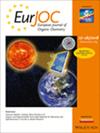天然产物合成中官能化顺式苯胺合成的立体选择策略
IF 2.5
3区 化学
Q2 CHEMISTRY, ORGANIC
引用次数: 0
摘要
顺式双环基序是一种常见的双环结构,在许多天然产物中发现,具有重要的生物活性。这种结构特征存在于各种生物活性化合物中,特别是萜类、类固醇和生物碱,它们以其治疗潜力而闻名,包括抗炎、抗菌、抗病毒和抗癌特性。由于其普遍性和生物学相关性,顺式氢丹框架引起了合成化学家的极大关注,他们投入了大量的精力来开发高效和多样化的方法来构建这一重要的基序。许多已合成的顺式氢丹化合物已被用作复杂天然产物全合成的关键中间体或构建块。本文综述了自2000年以来功能化顺式苯胺及其衍生物的合成方法,重点介绍了它们在天然产物合成中的应用。通过研究各种方法及其对天然产物合成的影响,本综述将强调顺式氢丹框架在合成有机化学和药物化学中的持久重要性。本文章由计算机程序翻译,如有差异,请以英文原文为准。

Stereoselective Strategies for the Synthesis of Functionalized Cis‐Hydrindanes in Natural Product Synthesis
The cis‐hydrindane motif is a bicyclic structure commonly found in many natural products that exhibit significant biological activity. This structural feature is present in a variety of bioactive compounds, particularly terpenoids, steroids, and alkaloids, which are known for their therapeutic potential, including anti‐inflammatory, antimicrobial, antiviral, and anticancer properties. Due to its prevalence and biological relevance, the cis‐hydrindane framework has attracted considerable attention from synthetic chemists, who have devoted substantial effort toward developing efficient and diverse methods for constructing this important motif. Many of the synthesized cis‐hydrindane compounds have been used as key intermediates or building blocks in the total synthesis of complex natural products. This review provides an overview of strategic approaches for synthesizing functionalized cis‐hydrindanes and its derivatives from 2000 to the present day, focusing on their application in natural product synthesis. By examining the diverse methods and their impact on natural product synthesis, this review will underscore the enduring importance of the cis‐hydrindane framework in both synthetic organic chemistry and medicinal chemistry.
求助全文
通过发布文献求助,成功后即可免费获取论文全文。
去求助
来源期刊
CiteScore
5.40
自引率
3.60%
发文量
752
审稿时长
1 months
期刊介绍:
The European Journal of Organic Chemistry (2019 ISI Impact Factor 2.889) publishes Full Papers, Communications, and Minireviews from the entire spectrum of synthetic organic, bioorganic and physical-organic chemistry. It is published on behalf of Chemistry Europe, an association of 16 European chemical societies.
The following journals have been merged to form two leading journals, the European Journal of Organic Chemistry and the European Journal of Inorganic Chemistry:
Liebigs Annalen
Bulletin des Sociétés Chimiques Belges
Bulletin de la Société Chimique de France
Gazzetta Chimica Italiana
Recueil des Travaux Chimiques des Pays-Bas
Anales de Química
Chimika Chronika
Revista Portuguesa de Química
ACH—Models in Chemistry
Polish Journal of Chemistry.

 求助内容:
求助内容: 应助结果提醒方式:
应助结果提醒方式:


